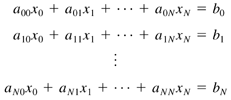Chapter 19. Solving Systems of Equations
| When performing a scientific or engineering analysis, things aren't always as easy as solving a single equation for a single unknown. There will be many times when you will need to solve a coupled system of equations for a vector of unknowns. There are different types of systems of equations. There are underspecified systems with more unknowns than equations. There are also overspecified systems with more equations than unknowns. In this chapter we will concern ourselves with solving systems, where the number of equations and unknowns are equal. Specifically, we will create a family of methods that solve a system of equations of the form shown in Eq. (19.1). Equation 19.1 The system of equations shown in Eq. (19.1) can be expressed in a more compact form as Equation 19.2 In both Eq. (19.1) and Eq. (19.2), the x vector contains the unknowns we want to solve. A number of algorithms have been developed over the years to solve systems of equations. We will look at three of them ”Gauss-Jordan elimination, Gaussian elimination , and Lower-Upper decomposition. The specific topics we will cover in this chapter are ”
|
EAN: 2147483647
Pages: 281
